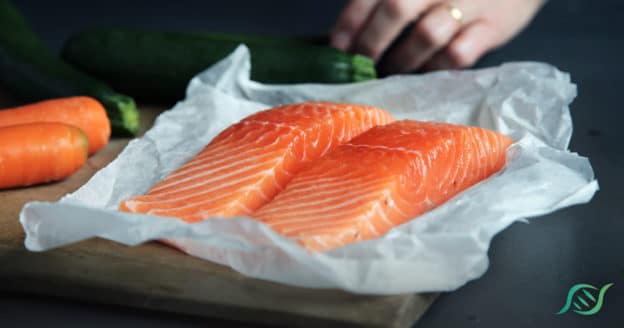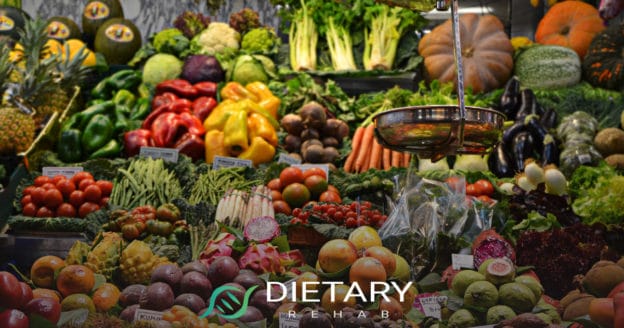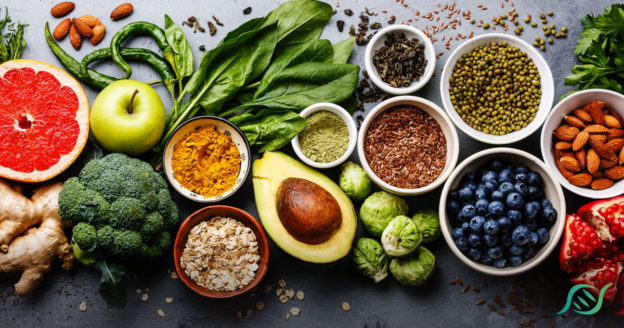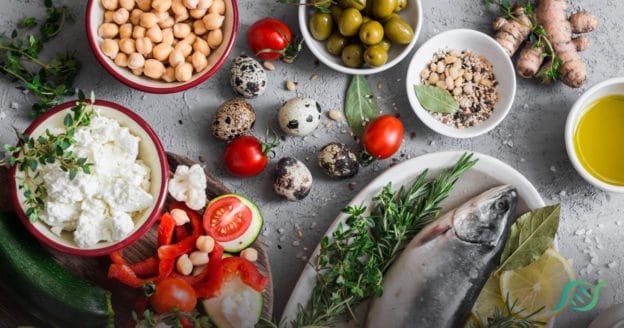 In last month’s article, Our Modern Food Addiction, I began laying the groundwork for a different way of looking at our modern obesity and dietary-induced chronic disease epidemic. In that article, I asked you to begin to open your mind and modify the way you look at food on the most basic level. Instead of food being a unit of energy, food should be seen as the powerful pharmaceutical agent that it is, which controls a very complex hormonal and biochemical environment. It is the corruption of this environment that what leads to poor health and weight gain. At the heart of the myriad of biochemical nutritional problems is one substance… sugar. Sugar not only contributes to terrible hormonal and biochemical environments in its own right, but actually is the engine which drives the poor health train due to one nasty biological effect which it has on our brain… it is a very addictive substance. As you will see, addiction causes a chain reaction of bad things to happen to your health, your weight, and your psychological relationship with food. We will begin exploring this phenomenon in this article by laying the physiological groundwork. We will take a look at the biology behind addiction, why a particular substance is addictive, and what happens when that substance is introduced into our systems.
In last month’s article, Our Modern Food Addiction, I began laying the groundwork for a different way of looking at our modern obesity and dietary-induced chronic disease epidemic. In that article, I asked you to begin to open your mind and modify the way you look at food on the most basic level. Instead of food being a unit of energy, food should be seen as the powerful pharmaceutical agent that it is, which controls a very complex hormonal and biochemical environment. It is the corruption of this environment that what leads to poor health and weight gain. At the heart of the myriad of biochemical nutritional problems is one substance… sugar. Sugar not only contributes to terrible hormonal and biochemical environments in its own right, but actually is the engine which drives the poor health train due to one nasty biological effect which it has on our brain… it is a very addictive substance. As you will see, addiction causes a chain reaction of bad things to happen to your health, your weight, and your psychological relationship with food. We will begin exploring this phenomenon in this article by laying the physiological groundwork. We will take a look at the biology behind addiction, why a particular substance is addictive, and what happens when that substance is introduced into our systems.
How We Got Here
Addictive substances have been around as long ashumanity has walked the earth. Anthropology tells us that our ancestors frequently used (and obviously enjoyed) a wide variety of addictive stimulants, depressants and other agents. We find in the bones of these primitive peoples traces of cannibis, caffeine, nicotine, mescaline, opium, and many other substances. The mummies of Egypt have been found with traces of cocaine, nicotine, and caffeine in their tissues. Utzi the iceman, who was found in the early 90’s completely preserved in glacial ice in the Swiss Alps and is the oldest intact mummy that we know of on earth contained traces of caffeine. The want of many of these addictive substances have driven many of our pursuits of exploration, conquest, and destruction of indigenous societies in the years of world-wide exploration and conquest. Cortez may have crossed the see in search of El Dorado, but he returned to Europe with nicotine, caffeine, and chocolate (theobromine) to start the Europeans buzzing (literally). And we all know of the terrible tragedies of slavery and sufferings of Africans for the want of rum during the triangle trade period. Truly, addictive substances have played a massive role in the history of our species.
But at what point does a substance go from and “addictive” substance that is consumed to an addiction in an individual? After all, there are many individuals who eat, drink, and inhale substances and never become addicted to them. We all know of the occasional drinker, the occasional smoker. When is the point reached where a person has to have a substance?
What makes a substance addictive?
There are literally billions of unique substances on this earth, and many of them we interact with in our environment on a daily basis. Air, water, various proteins, minerals, countless plant and animal proteins… It is mind-boggling how many things we come in contact with each day. So why do some of these substances make our bodies desire more and more of them, while the other we interact with without so much as a thought?
As it turns out, the properties of a substance that makes it addictive all boil down to the interaction of the substance with very particular portions of the brain. It is the neurotransmitter, hormonal and chemical responses by the brain to the substance which make a substance either innocuous or addictive. All addictive substances share many similarities with how they interact with the brain and the conditions that they produce in the brain. The following section is going to be a little technical and “science-ey”, so I apologize in advance for any headaches caused. I do promise to keep the technical jargon down to an absolute minimum, but I feel that it is important to explain the science behind addiction in some detail to give you a clearer picture of what is really going on in your body.
Brain Physiology:The Mesolimbic System
The part of the brain which is most involved in an addictive response to a substance is named the mesolimbic system. This “system” is actually more a collection of several distinct neural structures located in the cortex region of the brain. The primary constituent structures of the limbic system are the amygdala, hippocampus, septal nuclei, and anterior nucleate gyrus, and maybe the most important and well-known brain structure in regards to addiction is the nucleus accumbens. My intention certainly is not to overwhelm you with scientific terms or technical jargon. The real message is that the brain is incredibly complex, and that these structures have many diverse functions to carry out for the body. The hippocampus, for example, is responsible for the development of long-term memories. The piriform cortex has a significant role in the physiological process of smelling. The functions don’t necessarily relate to one another. But it is the reward and pleasure response functions of this system that we are interested in for our purposes. For simplicity’s sake, I will limit our discussion to the three portions of the mesolimbic system which are most prominently involved in addiction… the nucleus accumbens and the amygdala. I don’t want you to misunderstand, the reward center of the brain certainly is not the only player in the game when we talk about the physiology of addiction. Other systems, hormones, and neurotransmitters influence the reward pathway as well. But for our purposes an examination of the amygdala and nucleus accumbens show us the “beating heart” of the addiction response.
The Amygdala

The amygdala are two small, nodule-like structures situated deep in the middle of the brain. They are highly connected to several important parts of the brain such as the hypothalmus, trigeminal nerve the ventral tegmental area (VTA). It has a few rather diverse jobs in the grand scheme of things for the body, but the function that we are most concerned about with our subject is its role in positive learning. It forms memories of positive events (and substances) that you come into contact with and remembers that substance is a “positive” thing for some future time. This makes the amygdala very important in the process because it is essentially where the memory of the “good feeling” starts and ends. This has been shown conclusively in animal studies. When mice have their amygdala damaged, they no longer pursue the positive behaviors that other mice do.
Nucleus Accumbens
The nucleus accumbens is the structure of the brain most famous for being labeled the “pleasure center”. When we have a pleasurable experience in life, whatever it may be, chances are the nucleus accumbens is in a very active state. This little structure also connects to several other structures in the brain, including the amygdala and VTA. The actual biology is way beyond the scope of this article, but a simple explanation is that when you have a pleasurable experience, several other structures in the stimulate a release of the neurotransmitter dopamine in the nucleus acumbens. This dopamine then interacts with the nucleus accumbens, activating it and producing the “good feeling” that we experience.
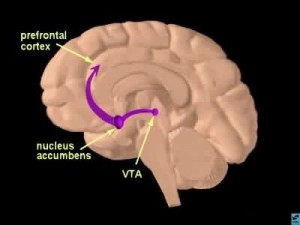
When it is functioning like it was designed to, it is a fascinating process. Nature has designed this chemical reaction specifically to put us in favorable positions as frequently as possible. This is because the things we experience in nature which cause this effect on our brain are generally good for us in a biological sense. Our bodies and the natural environment thus perform a beautifully precise dance with the substances it provides.
In order for this process to happen a substance is produced by the plant to heighten this pleasure response in our brain. As time passed through history, the plants who developed greater attractive substances ( sweeter fruit, caffeine, nicotine) thrived and dominated. Over the years, nature produced some very potent substances through this process of natural selection which exert a very high dopamine response in the nucleus accumbens. The end result? Addictive substances were born.
So the question is, if addiction is a natural process, then where did biology go wrong? Well, biology didn’t go wrong….mankind intervened in nature and did what we do time and time again…made a giant mess.
The truth is, these natural compounds in their native state aren’t particularly harmful or addictive. For instance, when taken in its natural form the coca leaf isn’t a terribly bad thing and only modestly addictive. However when man isolated, condensed, and purified the addictive substance contained in the coca leaf (cocaine), a highly addictive and terrible substance was born which enslaves many people to its effects. The same can be said for poppy seeds (opium, heroin), and many other drugs of addiction.
If you take an MRI of the brain of a heroine addict, a crack addict, and an alcoholic while they are in the midst of a binge of their substance of choice, the brain activity is nearly identical. They all have extremely active nucleus accumbens with surging dopamine levels in that part of their brain. So, how does this tie in to our dietary woes?
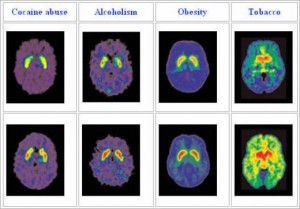 Brain Scans of Various Addicts vs. Normal Brains. Notice the similar level of activity (yellow vs. red).
Brain Scans of Various Addicts vs. Normal Brains. Notice the similar level of activity (yellow vs. red).
It just so happens that we use the same system of condensing and purifying for sugar. It has been proven in a multitude of studies that sugar effects the brain in an identical manner as the common drugs of addiction. When ingested, sugars stimulate a rapid and very high level of dopamine secretion in the nucleus accumbens. This is the exact condition which we believe triggers addiction in all its forms. So where is the real-world evidence?
Heavy sugar consumers, be it junk food junkies or high carbohydrate marathoners, display significant withdrawal symptoms when the sugar content of their diet is drastically reduced or eliminated. Heaches, diarrhea, nausea, fatigue, low grade fever, and shivering are the most common symptoms of sugar withdrawal. You have probably experienced these symptoms yourself if you have tried to crash diet, or simply suddenly went from being a couch potato to a strict diet overnight. These symptoms are hallmarks of addictive drug withdrawal.
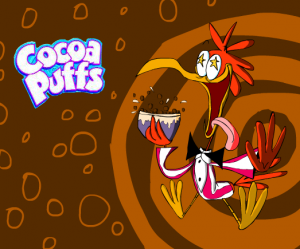 Proof of Sugar’s Addictive Properties. This Bird Has Been Whacked Out of His Mind on Sugar Since I was a Child
Proof of Sugar’s Addictive Properties. This Bird Has Been Whacked Out of His Mind on Sugar Since I was a Child
Of course, the one big difference between sugar and other addictive substances (alcohol excepted) is that sugar just happens to also contain calories. When you are addicted to sugar and the good feeling of contentment that it brings to you, you are also packing in tremendous amounts of caloric energy which must be accounted for. Thanks to sugar’s unique metabolic properties, these calories are particularly harmful and quite useless to a healthy human body. We will discuss sugar’s specific metabolic problems in next month’s installment, but for now just know that sugar calories are bad for you… with a capital B.
It is my belief that addiction to sugar in all of its permutations ( table sugar, high fructose corn syrup, etc.) is the beating heart of our obesity epidemic. I contend that only by recognizing sugar as an addictive substance instead of just a source of calories and then treating it as such in our diets will we begin to understand its effects on our physiology, psychology and corpulence.
There is one group in our society who has been clued in to the sugar and addiction relationship for years. Food manufacturers, over the past 30 years, have added high fructose corn syrup to everything they produce. You may not have even realized this unless you consciously read ingredients in your everyday food items. Do you think this is an accident? Of course it is not. They are well aware they are lacing their products with an addictive substance to ensure a heightened attraction to their products. Can you think of another reason they would put corn syrup in bread? Pretzels? Saltine crackers? Lunch meats? All of these products existed for an eternity without added sugars. Do you feel duped yet?
 These Guys Have Known About This Science for Decades
These Guys Have Known About This Science for Decades
The one point that I hope that you take home from this article is to begin viewing the food you eat not as energy, but as biologically active substances. You could even call them drugs, and in the final analysis that may be the most descriptive word for our food. They cause particular and measurable biological and biochemical responses to their ingestion. Many components of food target specific receptors in the body ( just like contemporary pharmaceuticals). Hippocrates once wrote, “Let food be thy medicine, and medicine be thy food.” I think he had it figured out 2000 years ago. The point I am trying to make is, don’t underestimate your food. To think of it as mere energy is to do your health and body composition a great disservice.
Where Do We Go From Here?
So sugar is an addictive substance, and you are an addict. So, where do we go from here? We will begin addressing how to deal with your dependence on sugar in the next installment, but your homework is two-fold:
- Read the labels of the food in your kitchen this week to see how many products you have been eating have hidden additive sugars
- At each meal, instead of thinking “how many calories is this?” think “how is this going to interact with my body?”
Until next time!



